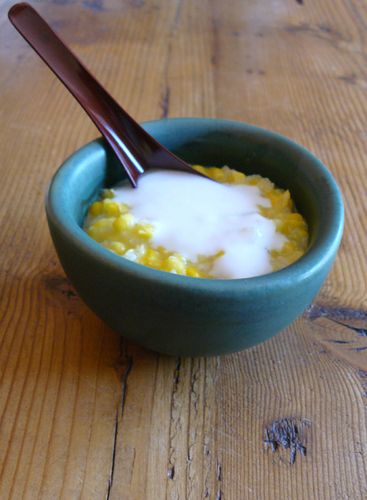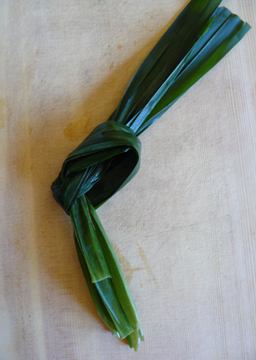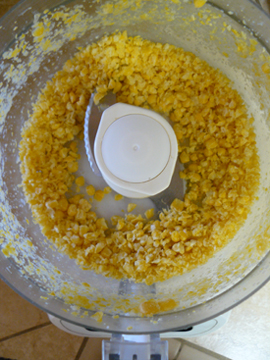Even though corn is native to the Americas, cooks in Asia love to cook with corn. In my Vietnamese kitchen, I celebrate the summer bounty of sweet corn by stir-frying corn with chiles and smoky, briny bits, frying up batches of corn and coconut fritters, blending corn into refreshing corn milk, and simmering pots of this creamy, risotto like sweet soup.
Called chè (“cheh”), sweet soups can be hot, warm, or cold. They are sold as street food, served at restaurants, and made at home. In Vietnamese communities abroad, there are even cafeteria-like chè bars where you can point to various cooked ingredients and the clerk will combine them in a cup for you to eat in or takeaway. Look for chè at Vietnamese banh mi sandwich shops too; they’re typically sold in plastic see-through cups.
Vietnamese sweet soups are beloved snacks that aren’t cloyingly sweet. Last week on Twitter, Leah Crow (@cabeah) asked me to for this sweet soup, which she’d just enjoyed at a Vietnamese restaurant. I tweeted back a 140-character recipe but didn’t feel like the tweet was enough. With leftover ears of corn from Labor weekend, I made a batch of (“cheh bahp”) and jotted down the recipe for Leah and you to use.
Recipe: Corn and Coconut Sweet Soup | Che Bap
It’s so easy to fall in love with this che preparation. You don’t have to have the pandan leaf (screwpine leaf) but it adds a grassy, floral note that’s very Vietnamese, particular from the southern region. Frozen pandan leaf works just fine as the fresh leaf is hard to find in the United States. Buy the leaves at Southeast Asian markets. Similarly, get the sweet (sticky) rice at the Asian market too. But if you don't have the rice, use tapioca pearls (bot bang), which are sold at mainstream supermarkets. Note that you can make this sweet soup and sauce days in advance for your reheating pleasure.
Serves 4 to 6
Coconut sauce
1 cup coconut milk
2 pinches of salt
1 tablespoon sugar
3 tablespoons water
1 ½ teaspoons cornstarch dissolved in 2 teaspoons water
3 cups water
¼ cup sweet rice, rinsed and drained, or small tapioca pearls (about ⅛ inch in diameter)
3 ears of corn, or 1 (16-ounce) bag frozen sweet corn
⅓ cup coconut milk
5 tablespoons sugar
½ teaspoon salt
3 large or 5 medium pandan leaves, rinsed and tied into a knot, optional (see the photo below)
½ teaspoon vanilla extract
1. To make the coconut sauce, combine the coconut milk, salt, sugar, and water in a small saucepan. Place over medium heat and bring to a near-simmer, lowering the heat if the coconut milk spits or pops. Give the cornstarch mixture a good stir and add it to the sauce, mixing well. Cook, stirring, for about 30 seconds, or until the sauce thickens; then remove from the heat.
2. Let the sauce cool, uncovered, to concentrate the flavors before serving. It will keep in a tightly closed container in the refrigerator for up to 3 days. Before using, reheat gently over low heat.
3. For the corn soup, put the water in a saucepan and it to a boil over high heat. Add the rice, stirring to prevent them from sticking together. Boil, stirring occasionally, for about 5 minutes, or until the rice is nearly cooked. If using the tapioca pearls, it will take 12 to 14 minutes for them to turn halfway clear; look for a tiny white dot in the center of each pearl. The water will seem slightly thick and viscous.
4. Meanwhile, if you are using, cut the kernels off the cob. If you are using frozen corn, thaw it for about 20 minutes. You should have 3 generous cups. Regardless of the corn used, use a processor to render it into a coarse texture.
5. When the rice (or tapioca pearl) is ready, add the coconut milk, sugar, salt, and pandan, stirring to dissolve the sugar. When the mixture comes to a near boil, add the corn. Lower the heat to a simmer and cook for about 5 minutes, or until the corn is cooked and the flavors are blended. Remove from the heat and stir in the vanilla. Allow the soup to cool for about 15 minutes. The resulting sweet soup will be thickish, like Italian risotto. Taste and adjust with more sugar and salt, if necessary. (The soup may be prepared up to 2 days in advance, tightly covered, and refrigerated. Warm over low heat, adding a splash of water to thin and prevent scorching, before serving.)
6. To serve, ladle the soup into small bowls and top with the coconut sauce.




















kris says
This looks really good. I was wondering where can you buy pandan leaves in the East bay?
Leah says
Thanks! This is a great post!! I am excited to try it!
Cindy says
sorry if this is a dumb question, but what is "sweet rice"?
Thien-Kim says
Looks yummy! One of my faves is Che Chuoi. My non-Viet husband loves it too. First time I made it I used colored tapioca pearls and it turned pink! LOL. Not pretty but it tasted good.
Joel says
sweet rice is perhaps sticky rice or glutinous rice. It looks non-transparent white when raw, and as the name suggests, turns into a very sticky soft rice when cooked. Normally you will steam it if you want to make cooked whole sticky rice, but obviously throw it into pots for making sweet soup.
Andrea, one thing I love about sweet soup is it is so easy and almost foolproof to make that even inexperienced yound cooks will produce successful ones, and yet so versatile with unlimited combinations. It looks a lot like a typical Cantonese "tong sui" that I often make at home during weekends. All the ingredients are just as commonly used in Cantonese sweet soups with the exception of pandan leaves.
Andrea Nguyen says
Kris, go to one of the Viet/Chinese markets in Oakland Chinatown or to 99 Ranch for the pandan leaves.
Andrea Nguyen says
Cindy, that's not a dumb question at all! Sweet rice is glutinous rice/sticky rice. A Chinese or Southeast Asian market is your best bet, though I've seen it at Whole Foods in LA.
Andrea Nguyen says
Joel -- "tong sui" -- does that literally mean sweet soup? I believe that the northern Vietnamese version of this sweet soup doesn't have the pandan. That's so neat that there's a Cantonese version of this. Thanks for the info, as always.
Crazy Cake Lady says
I love Che Bap, thanks for posting this!
BTW, "tong sui" literally translated is "sugar water" but is used generally to refer to any sweet soup desserts. 🙂
Andrea Nguyen says
Thanks for the clarification on tong sui, Crazy Cake Lady!
Joel says
Andrea, corn with sticky rice sweet soup is probably not a traditional standardized recipe in Cantonese cooking like mung bean or azuki bean soup or stewed white fungus with bird's best, but I do vaguely remember many people who make it out of "let's make a tong sui by throwing what we have in the pantry into the pot" moment.
For sticky rice soup, which we call sticky rice congee (糯米粥), my great aunt would add in some azuki beans (not too much), black eye beans, peanuts, black hair seaweed (black moss), and some dried longans.
Speaking of the terms, the literal English translation for "tong sui" is more like "sugary water" (糖水). The northern Chinese would call it "tim tong" (甜湯) (or "tian tang" in Mandarin), which is translated literally into "sweet soup". It seems to me that the shared preparation between che and tong sui would reinforce the hypothesis that the Vietnamese and Chinese in Guangdong share a common ancestry in antiquity.
benecio says
Looks very nice. Thanks for sharing!
Anonymous says
What are the pandan leaves used for? I have never seen them before in the recipe.
Andrea Nguyen says
Joel -- Thanks for clarifying. I've seen plenty of Viet cooks take the same approach to making sweet soups -- everything but the kitchen sink, add water, and some sugar. Boil.
Wow, the black hair seaweed must add color, texture, and slight viscosity. Yep, sweet soups are a cultural link between China and Vietnam. The range of them is staggering.
PANDAN - The pandan imparts a grassy, tea-like perfume. Thanks for pointing out the omission. That's a typo. I just made the correction.
Binh says
There's no comparison between frozen and corn on the cob. I remembered shaving the corn kernels with a vegetable peeler so that you have thin slices of the kernels instead of the whole piece. Doing so changes the texture of the dish, as well as release the liquid from insider the kernels.
Andrea, very nice touch with the pinch of salt in the coconut milk. That makes a huge difference in the taste because of the sweat/savory contrast.
Andrea Nguyen says
Binh -- Yep, shaving thin pieces of corn off the cob. That is lovely, isn't it? I suppose you could shave it off too with a gadget but I think the knife works well. The processor here results in a more uneven texture, I must admit. The salt is really nice for bringing out the sweetness of the corn.
V says
I just made this with frozen corn and it turned out wonderfully yummy! And it was so simple to make too. I love your recipes and the extra behind-the-scenes information you add within the blog to help explain ingredients and techniques. All you need now is your own cooking show. You'd be one to watch!!!
phuonglan says
is there another name in Vietnamese for "wheat starch"? And is there a substitution if wheat starch cannot be found?
discount coach says
We should all be concerned about the future because that is where we will spend the remainder of our lives.
Jordan retro 4 says
To believe that the warm, beautiful, trust, dignity, and strong, not decadent, empty, humiliate yourselves, injure others.
oakley sunglasses says
Yum! Even the pharmaceutical industry, historically tied to long-term investment cycles, cut 69,000 jobs in 2009, up 60% from 2008:)
carpinteyrouhd says
Identitaccepted educator" et qualité de making, franklin marshall confectionne des lignes de vêtements respectueuse de la synod universitaire,Vente vetements franklin marshall femme Pas Cher Boutiques.
tn says
I just made this. Unfortunately it came out not sweet enough and not enough sweet rice so it didn't taste like any of the che bap I've had in Vietnam or in US delis. I would add more sugar (7-8 TSP to taste) and up the rice to 1/2 cup next time.
marlon says
We should all be concerned about the future because that is where we will spend the remainder of our lives.
Duyen Nguyen says
I followed your recipe and the soup wasn't thick. Was there too much water (3 cups) for 1/3 cup of sweet rice and corn? Should i add corn starch?
Andrea Nguyen says
Duyen, there's 3 years of corn not 1/3 cup. The 1/3 cup of rice is correct. If you cut off the kernels from the 3 ears of corn, you'll have plenty.
lillie says
SWEET RICE = glutenous or sticky rice. It is NOT the normal long-grain white rice, but it is usual labled "sweet" "glutenous" or "sticky" rice. Hopes that helps. If you still don't understand,ask the clerk at the store. I think they should be able to point you to the right one.